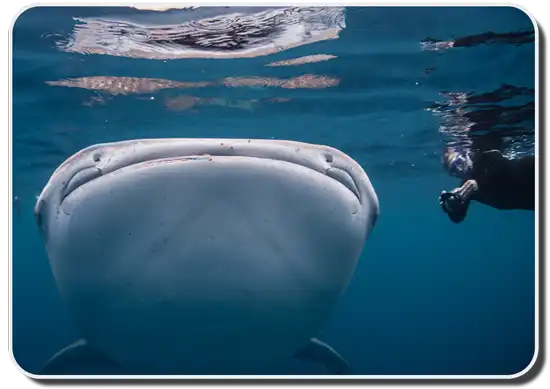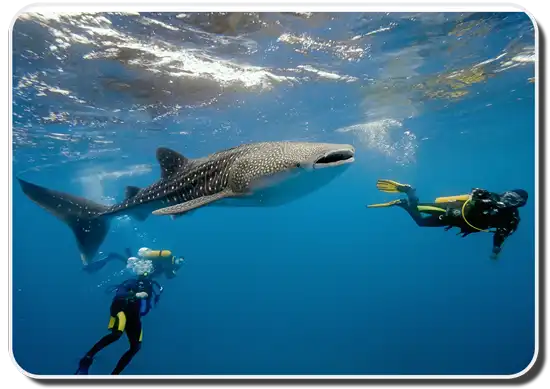
The largest shark species in the world ironically eat the smallest animals.
Whale Sharks, Basking Sharks, and Megamouth Sharks all grow to massive lengths, they all eat by filtering out plankton from the sea water.
These sharks are found all over the globe and are incredibly fascinating examples of shark species. Though they are all gentle giants sharing the same diet, each species has a unique biology, habitat, and behavior. Let’s learn more about these interesting sharks:
Whale Sharks

Whale Sharks are the largest known fish on the planet, measuring an average of 41.5 feet in length and weighing around 47,000 lbs. They have wide flat heads, with a rounded snout containing a massive, 4.9 feet wide mouth. Inside their mouths are 300-350 tiny teeth and 10 filter pads. On the sides of their heads, just behind their mouths they have two small eyes and two spiracles, small gill slits used to breath. Whale sharks are blue-grey or brown with light yellow and white spots and stripes on their backs and a smooth white underbelly containing five large gills slits. They also have two large pectoral fins and two large dorsal fins.
Whale sharks have a large habitat and tend to be long range swimmers. They prefer tropical and subtropical waters, with temperatures averaging 72 degrees fahrenheit. Though often found in the open water, they tend to stay near the surface of the water. Sometimes they will congregate along the coasts where it is believed they mate.
The Whale Shark diet consists mainly of zooplankton. These magnificent creatures have a truly unique way of filter feeding. They are active filter feeders which means they either suction water into their mouths or they ram feed which means they swim forward forcing the water and food into their mouths. Once they have water and food in their mouths, the filter pads separate the water from the plankton. Whale Sharks tend to filter between 3-6 pounds of food an hour. Small fish are also part of the Whale Shark diet, but they will only feed on them when plankton is sparse.
Basking Sharks

Basking Sharks are the second largest fish in the world. Basking Sharks grow up to 26 feet in length and weigh up to 5 tons. There have been some estimates that Basking Sharks can reach up to 33 ft in length. On average a Basking Shark has a mouth that is 3 feet wide containing tiny hooked teeth. The Basking Shark is bluish-grey with a white underbelly. They are often mistaken for Great White Sharks because of having a similar body shape and fins. Also, like Great White Sharks, they have gill slits that circle their neck.
Basking Sharks have a larger range than Whale Sharks. They prefer cooler waters with temperatures around 46-58 degrees fahrenheit, though they often migrate across warmer waters during seasonal changes. Their habitat is usually determined by the abundance of food in the water. They are often found close to the surface but have been known to dive as deeply as 2,990 feet.
Basking Sharks differ from Whale Sharks in their feeding behaviors as well. Basking Sharks are passive feeders, meaning they take in water as they swim. Basking Sharks swim at roughly 2.3 mph with their mouths open and gill rakers erect and take in up to 2,000 tons of water in an hour. They tend to feed near the surface and often by the mouths of rivers, and will eat continuously around the clock.
Megamouth Sharks
The Megamouth Shark is the smallest of the three filter feeder sharks. Megamouth Sharks can grow to 18 feet in length. Though female Megamouth Sharks tend to grow to an average of 16 feet, while males grow to an average of 13 feet. They megamouth has a stout, chubby body that is brown with a white belly. The megamouth has a long tail with a longer top caudal fin than the lower. Megamouth sharks have protruding mouths that grow to an average of 4.3 feet wide. Their mouths are lined with hundred of small, nonfunctional teeth in 50 rows.
Megamouth Sharks are incredibly rare. There have only been 55 confirmed sightings of Megamouth Shark in history. Megamouth Sharks prefer warm tropical waters and are found in the Pacific, Atlantic, and Indian Oceans. They are vertical migrants spending their days at a depth of 390-520 feet and their nights near the surface between 39-82 feet. Megamouth Sharks tend to follow the vertical migration patterns of plankton.
Megamouth Sharks are very slow swimmers, moving around a mile an hour. Like Basking Sharks they are passive filter feeders. However, scientists believe that the Megamouth Shark may also feed by suction like the Whale Shark, but this has yet to be observed in the wild. While they swim, Megamouth Sharks move water through their mouths and out their gills, trapping food with their gill rakers. The mouth of the Megamouth Shark is uniquely designed to attract unsuspecting prey. The Megamouth Shark’s mouth is surrounded by bioluminescent organs called photophores that illuminate.
As you can see there are some incredible differences between the three filter feeding sharks. Though they are all large, docile creatures that feed on small plankton, they each have unique characteristics to their species. Whale Sharks are the largest and most active feeders, Basking Sharks look like deadly Great White Sharks but are really slow passive feeders, and Megamouths are vertical hunters that trap their prey with light. Filter feeder sharks highlight the diversity of shark species, having wildly different behaviors and features than their counterparts.
